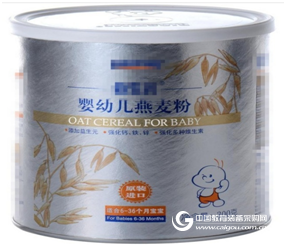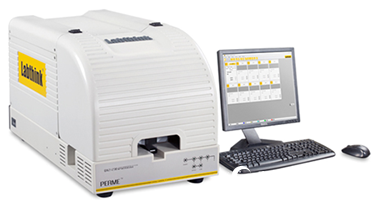Abstract: Rice flour is an important complementary food for infants and young children. It contains a lot of protein, minerals and vitamins, which is easily oxidized by external oxygen to cause deterioration. Therefore, in order to prevent external oxygen from entering, the paper aluminum plastic can packaging which is often used should have high oxygen barrier properties. This paper uses Labthink OX2/230 oxygen transmission rate test system to test the oxygen barrier performance of paper aluminum-plastic can packaging, and introduces the basic process of the test and the applicable scope and equipment parameters of the test equipment. Performance test equipment and test methods can be referred to.
Key words: infant food supplement, rice flour, paper aluminum plastic can, oxygen barrier, oxygen barrier performance, oxygen transmission rate, oxygen transmission rate test system
1, meaning
Infant rice noodles, also known as infant formula, cereal flour, nutritious rice flour or infant rice cereal, is an auxiliary food for supplementing infants and young children when breast milk or infant formula can not meet the nutritional needs of infants and during weaning. It is based on millet and rice, supplemented by white sugar, vegetables, fruits, eggs, meat and other ingredients. It is supplemented with calcium, phosphorus, iron, zinc and other minerals and vitamins.
In order to extend the shelf life of products and reduce packaging costs, the food industry is gradually using paper aluminum plastic cans instead of aluminum cans. In order to prevent the quality problems such as oxidative deterioration of rice flour, the oxygen barrier property of paper aluminum-plastic cans is also high. If the oxygen barrier property is poor, that is, the oxygen permeability is high, the rice flour is easily infiltrated into the oxygen from the outside. Oxidation causes quality problems such as oxidative deterioration and mildew of rice flour, which not only shortens the shelf life, but also seriously attacks the corporate brand image. Therefore, it is necessary to strengthen the detection of oxygen transmission rate when selecting packaging materials.

Figure 1 Infant rice noodle paper aluminum plastic can packaging
2, the implementation of standards
The domestic test method for the oxygen permeability of packaging containers is based on the Coulomb test method. Refer to GB/T 31354-2014 "Copper Test Method for Oxygen Permeability Test Method for Packages and Containers". This standard was implemented in 2015 and specifies test methods for the oxygen permeability of packages and containers using coulometric methods under steady-state conditions and plastics and composites with a volume of less than 2 L suitable for use in dry environments. Oxygen permeability testing of packaging materials such as packages and containers.
3, test samples
A sample of paper aluminum and plastic cans for infant rice noodles provided by a company.
4, test equipment
Jinan Languang Electromechanical Technology Co., Ltd. independently developed and designed the OX2/230 oxygen transmission rate test system.

Figure 2 OX2/230 oxygen transmission rate test system
4.1 Test principle
OX2/230 adopts the isobaric test principle (ie, the coulomb test method), clamping the pre-treated sample between the test chambers, oxygen or air flowing on one side of the film, and high-purity nitrogen in the film. Flowing on one side. Oxygen molecules diffuse through the membrane to the high purity nitrogen in the other side and are carried to the sensor by the flowing nitrogen. By analyzing the oxygen concentration measured by the sensor, parameters such as oxygen transmission rate are calculated. For packaging containers, high purity nitrogen flows within the container, and air or high purity oxygen surrounds the outside of the container.
4.2 Scope of application
(1) This equipment is suitable for oxygen transmission rate testing of containers, plastic film, sheet, paper, cardboard and composite materials.
Containers include oxygen transmission rate tests for bottles, bags, cans, boxes, and barrels made of plastic, rubber, paper, paper-plastic composite, glass, metal, etc., such as Coke bottles, peanut oil barrels, Tetra Pak, Vacuum packaging bags, metal three-piece cans, plastic cosmetic packaging, toothpaste hoses, jelly cups, yogurt cups, etc.
The film materials include oxygen transmission rate tests of film materials such as various plastic films, plastic composite films, paper-plastic composite films, co-extruded films, aluminized films, aluminum foils, and aluminum foil composite films.
The sheet material includes oxygen transmission rate tests of various sheet materials such as engineering plastics, rubber, and building materials, such as PP sheets, PVC sheets, and PVDC sheets.
In addition, the special configuration fixture of this equipment can also be applied to oxygen transmission rate test of special packaging such as medical packaging, automobile fuel tank, battery plastic casing, plastic pipe and solar backing.
(2) This equipment can meet a number of national and international standards, such as GB/T 31354, ISO 15105-2, GB/T 19789, ASTM D3985, ASTM F2622, ASTM F1307, ASTM F1927, JIS K7126-2, YBB 00082003.
4.3 Equipment parameters
Test range: film test 0.01 ~ 6500 cm3 / (m2 · d), container test 0.0001 ~ 60 cm3 / pkg · d.
Number of samples: Three identical or different samples can be tested simultaneously.
Resolution: Film 0.001 g/m2·24h, container 0.00001 g/pkg·d.
Test temperature range: 15 ° C ~ 55 ° C, temperature control accuracy ± 0.1 ° C.
Test humidity range: 0% RH, 35% RH ~ 90% RH, temperature control accuracy ± 1% RH.
Test gas: O2, air (air source user-supplied).
The system can support up to 10 instruments in parallel connection, and establish an efficient system for simultaneous testing of 30 samples.
It can be combined with the water vapor transmission rate test system to form a hybrid test system, which is controlled by a computer to achieve an efficient and convenient test method for simultaneous oxygen and water vapor transmission rate testing.
Support LystemTM laboratory data sharing system to manage test results and test reports.
5, the test process
(1) Fix the test container special device to the bottom of the paper aluminum-plastic can with the fast-setting glue. After the sealing is completed, connect it to the instrument, and then seal the sample and special device with a sealed bag.
(2) Set the sample name, test temperature, test humidity and other parameters.
(3) Click the "Start Test" option.
(4) Start the air supply, adjust the humidity and the carrier gas flow.
(5) After the test is over, the instrument automatically calculates and displays the test results.
6, test results
The oxygen transmission rate of the infant rice noodle paper aluminum-plastic cans tested in this paper is: 0.0249 cm3/pkg·d.
7. Conclusion
The barrier performance of the packaging can is an important factor affecting the shelf life and taste of infant rice noodles, especially the barrier to external oxygen. The higher the barrier property, the smaller the oxygen transmission rate, the longer the shelf life of rice flour. The OX2/230 Oxygen Transmission Rate Test System is an oxygen transmission rate tester for thin film testing and container testing. It has simple operation, high test accuracy and high repeatability. Labthink has been committed to providing professional equipment and testing services to customers around the world, providing customers with a large number of packaging material performance data references. For details, you can log in to view. Labthink is looking forward to technical exchanges and cooperation with users in various industries.
Carved Lipstick,Lip Rouge,Lip Paste,Lip Gloss,Lip Balm
Guangzhou Shishi Daily Chemical Co.,Ltd. , https://www.gzcosmeticok.com
![<?echo $_SERVER['SERVER_NAME'];?>](/template/twentyseventeen/skin/images/header.jpg)